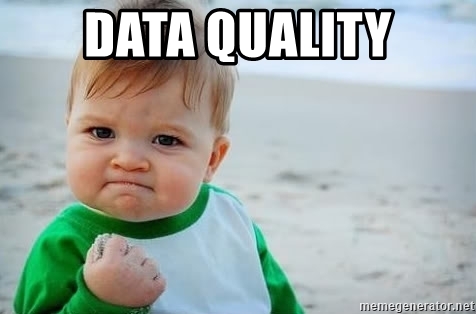Think of this: it is the birthday of one of your best friends and due to the Covid-19 measures you cannot get together. You still want to create a special moment though, therefore you decide to send a birthday card to his or her address. However, one week went by and you still did not hear anything from your friend. After texting multiple times you still do not receive a reply so you decide to make a phone call. Your friend answers but is really pissed, you forgot the birthday. How is this possible you think, you send a card one week in advance… The answer: Incorrect master data. You check your phone and you realize that you send the card to the wrong address.
Data quality
As you just read, many decisions are based on data. This happens not just in your personal life, but also on a business level. The importance of this data-based decision-making is once again stressed in the literature. Haug & Stentoft Arlbjørn (2011) for example state in their research that few would disagree with the statement that high data quality is the precondition for the efficiency of a company. Moreover, Knolmayer and Röthlin (2006) state master data is one of the main components of most information systems. Given the importance of master data, the quality of master data has taken a spot on increasing prominence on the agenda of companies (Otto et al., 2011). So what is master data actually?
What is master data?
Master data is described as the core data within an organization. This is for example data from or about customers, suppliers or accounts. As described by Kanters et al. (2020) master data is data that typically describes the people, places and things that are involved in an organization’s business. Whereas master data is almost always structures data (Kanters et al., 2020), master data is easy understandable for machine learning purposes and often highly structured.
Why is high quality master data so important?
The reason that high quality master data is so important lies in the fact that modern decision-making is often based on data gathered by or from within the organization. Think for example of a retailer in the fashion industry. The business model of this retailer is an online only repository for customers to order their clothes of multiple brands and get them delivered to their homes. This retailer has multiple warehouses spread over a country. Depending on the order of a customer he or she receives products from one of the three warehouses. When warehouse A receives a change to a customer’s master data (e.g. address change), but due to the differences in terminology between the warehouses stores it under a different name (e.g. street name instead of address) it is not properly communicated to the other warehouses. When the same customer now orders something which is delivered from a different warehouse the order is delivered to the wrong customer address.
Say the retailer delivers 1000000 packages a year. If a wrong delivery happens 0.1% of the time, and the costs of a wrong delivery are 10 euro, this would mean the retailer loses out on 1000000 euro per year.
Ensure the quality of your master data
As you have seen throughout this short article, master data stresses the most important data within the organization. If the quality of this data is not ensured, companies can lose out on large amounts of money. In addition to this, it can also damage how customers perceive a brand or result in a subsidiary being opened at the wrong location. Although it might be difficult, high quality master data can be ensured in multiple ways. One of these is by having the proper data management tools in place (Kanters et al. 2020), but that is a story for another time.
References
data quality meme – Google zoeken. (2020). Google. https://www.google.com/search?q=data+quality+meme&rlz=1C1GCEU_enNL905NL905&source=lnms&tbm=isch&sa=X&ved=2ahUKEwjuqbKBkZnsAhXG-aQKHfX0AQMQ_AUoAXoECAsQAw&biw=2133&bih=1022#imgrc=8ePGNJnr3vxxwM
Haug, A., & Stentoft Arlbjørn, J. (2011). Barriers to master data quality. Journal of Enterprise Information Management, 24(3), 288–303. https://doi.org/10.1108/17410391111122862
Kanters, T., Bonnema, P., Hoffman, C., & Verhoeven, R. (2020, July). What can proper Data Management do for you? KPMG Sofy. https://www.kpmgsofy.com/data-management/download-whitepaper/
Knolmayer, G. F., & Röthlin, M. (2006). Quality of Material Master Data and Its Effect on the Usefulness of Distributed ERP Systems. Advances in Conceptual Modeling – Theory and Practice, 362–371. https://doi.org/10.1007/11908883_43
Otto, B., Hüner, K. M., & Österle, H. (2011). Toward a functional reference model for master data quality management. Information Systems and E-Business Management, 10(3), 395–425. https://doi.org/10.1007/s10257-011-0178-0


